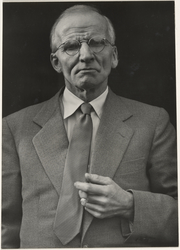Albert Renger-Patzsch (June 22, 1897 – September 27, 1966) was a German photographer associated with the New Objectivity.

Renger-Patzsch was born in Wurzburgand began making photographs by age twelve.[1] After military service in the First World War he studied chemistry at Dresden Technical College. In the early 1920s he worked as a press photographer for the Chicago Tribune before becoming a freelancer and, in 1925, publishing a book, The choir stalls of Cappenberg. He had his first museum exhibition in 1927.
In 1928 Renger-Patzsch published The World is Beautiful, a collection of one hundred photographs whose rigorous sensitivity to form revealed patterns of beauty and order in the natural and man-made alike. Embodying a new, distinctly modern way of looking at the world, the book established Renger-Patzsch as one of the most influential photographers of the twentieth century.
in 1925 Renger-Patzsch began to pursue photography as a full-time career as a freelance documentary and press photographer. He rejected both Pictorialism, which was in imitation of painting, and the experimentation of photographers who relied on startling techniques. In his photographs, he recorded the exact, detailed appearance of objects, reflecting his early pursuit of science. He felt that the underlying structure of his subjects did not require any enhancement by the photographer. In his book Die Welt ist schön (1928; “The World Is Beautiful”), he showed images from both nature and industry, all treated in his clear, transparent style. Such images were closely related to the paintings of the Neue Sachlichkeit movement of painters, who created detached and literal renderings of reality that were so extreme that they produced an eerie effect.
one of my favourite work hes done:

this is a black and white photo of what seems to be some kind of flora.
